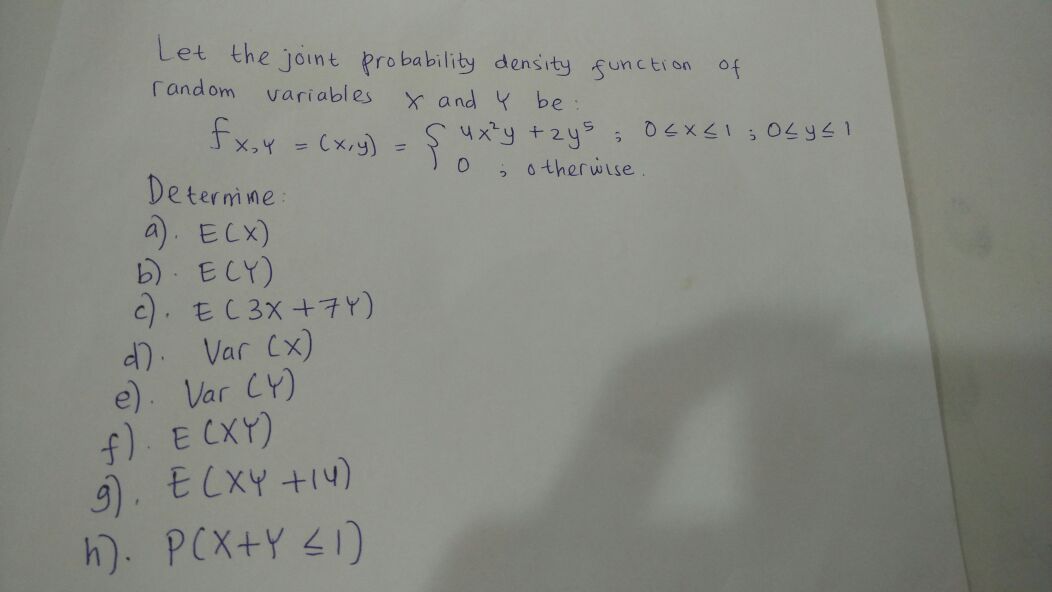Help me about mathematical statistics please? I really need help for preparing my midterm in mathematical statistics. Thank you very much for your help.

1 Answer
Given
Let
Let
The support is the 2-D region
a)
When
#E[g(X,Y)] = int_A int_B g(x,y)f_(X,Y)(x,y)" "dy" "dx#
Of course, the function
#E[X] = int_A int_B x" "f_(X,Y)(x,y)" "dy" "dx#
For this question:
#E(X) = int_(x=0)^1int_(y=0)^1x(4x^2y+2y^5)" "dy" "dx#
#color(white)(E(X)) = int_(0)^1 x int_(0)^1(4x^2y+2y^5)" "dy" "dx#
#color(white)(E(X)) = int_(0)^1 x [2x^2y^2+1/3 y^6]_(y=0)^1" "dx#
#color(white)(E(X)) = int_(0)^1 x (2x^2+1/3)" "dx#
#color(white)(E(X)) = int_(0)^1 (2x^3+1/3 x)" "dx#
#color(white)(E(X)) = [1/2 x^4+1/6 x^2]_(x=0)^1#
#color(white)(E(X)) = 1/2 + 1/6#
#color(white)(E(X)) = 2/3#
b)
I'll leave the calculation of
c)
Using the rules of expectation, we get
#E(3X+7Y)=E(3X) + E(7Y)#
#color(white)(E(3X+7Y))=3E(X) + 7E(Y)#
#color(white)(E(3X+7Y))=3(2/3) + 7(46/63)#
#color(white)(E(3X+7Y))=2+46/9#
#color(white)(E(3X+7Y))=64/9#
d)
Recall by the definition of variance:
#"Var"(X) = E{[X-E(X)]^2} = E(X^2)- [E(X)]^2#
We already know
#E(X^2) = int_(x=0)^1int_(y=0)^1x^2(4x^2y+2y^5)" "dy" "dx#
#color(white)(E(X^2)) = int_(0)^1 x^2 int_(0)^1(4x^2y+2y^5)" "dy" "dx#
#color(white)(E(X^2)) = int_(0)^1 x^2 [2x^2y^2+1/3 y^6]_(y=0)^1" "dx#
#color(white)(E(X^2)) = int_(0)^1 x^2 (2x^2+1/3)" "dx#
#color(white)(E(X^2)) = int_(0)^1 (2x^4+1/3 x^2)" "dx#
#color(white)(E(X^2)) = [2/5 x^5+1/9 x^3]_(x=0)^1#
#color(white)(E(X^2)) = 2/5 + 1/9#
#color(white)(E(X^2)) = 23/45#
Thus,
#"Var"(X) = E(X^2)- [E(X)]^2#
#color(white)("Var"(X)) = 23/45- (2/3)^2#
#color(white)("Var"(X)) = 23/45- 4/9#
#color(white)("Var"(X)) = 1/15#
e)
Once again, I'll leave this one as practice. You should get
f)
Same as before, but with
g)
We use the properties of expectation again to get
#E(XY+14)=E(XY) + E(14)#
#color(white)(E(XY+14))=10/21 + 14#
#color(white)(E(XY+14))=304/21#
h)
We're looking for the probability of being in the part of the support that satisfies
#x+y<=1#
#=>" "y<=1-x#
Combining this with the given restrictions
We can picture covering this region as follows: as
Thus, our probability is
#"P"(X+Y<=1)= int_(x=0)^1int_(y=0)^(1-x)f_(X,Y)(x,y)" "dy" "dx#
#color(white)("P"(X+Y<=1))= int_(0)^1int_(0)^(1-x)(4x^2y+2y^5)" "dy" "dx#
#color(white)("P"(X+Y<=1))= int_(0)^1 [2x^2y^2]_(y=0)^(1-x)" "dx#
#color(white)("P"(X+Y<=1))= int_(0)^1 2x^2(1-x)^2" "dx#
#color(white)("P"(X+Y<=1))= int_(0)^1 (2x^2-4x^3+2x^4)" "dx#
#color(white)("P"(X+Y<=1))= [2/3x^3-x^4+2/5x^5]_(x=0)^1#
#color(white)("P"(X+Y<=1))= 2/3-1+2/5#
#color(white)("P"(X+Y<=1))= 1/15#

